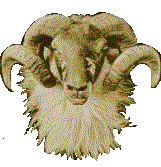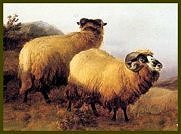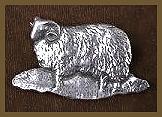HOME | home
Ca' the Ewes to The Knowes | Queen Among The Heather | The Broom of Cowdenknowes | Bonny May | Searching for Lambs | Heather Down the Moor | The Shepherd's Wife | Tarry Wool | Stormy Winds | Shepherd of the Downs | The Sheep-Shearing Song | The Sheep Shearing | Rosebud in June | Lincolnshire Shepherd | Sheep Shearin | Drink Boys, Drink | Darby Ram | Ewie wi' the Crookit Horn | Master of the Sheepfold | The Sheep Under the Snow | The Weary Pund O' Tow | Sheep Crook and Black Dog | The Shearing's Nae For You | Band of Shearers | Twanky Dillo | The Shepherd Lad O' Rhynie | Laird o' Drum | Blind Shepherd | Canny Shepherd Laddie | Road to the Isles | Tip O' Derwent
Darby Ram

As I went in to Darby,
All on a Market Day,
I saw the largest ram, sir,
That was ever fed on hay.
CHORUS:
And he rambled, rambled all around
In and out of town did he ramble,
And he rambled til them butchers cut him down.
This ram had four feet, sir,
Four feet on which to stand,
And each one of his hooves sir,
covered an 40 acres of land.
CHORUS
The wool upon his back, sir,
It reached up to the sky;
The eagles made their nests there,
You could hear the young ones cry.
CHORUS
The horns upon his head, sir,
They Reached up to the moon;
A man climbed up in January,
And didn't come down 'til June.
CHORUS
The wool that grew upon his tail,
If you had sheared it off,
Would have made the finest tailors
A hundred yards of cloth.
CHORUS
The Butcher that cut him down sir,
He drownded in the blood.
And the little boy who held the bowl,
Was washed away in the flood.
CHORUS
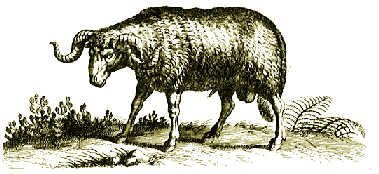
Version 2
A second version of the lyrics is given here:
THE DARBY RAM
As I went down to Darby, Sir, 'twas on a market day,
I saw the finest ram, Sir, that ever was fed on hay.
Chorus:
And indeed, Sir, 'tis true, Sir, I never was taught to lie,
And if you'd been to Darby, Sir, you'd have seen him the same as I.
He had four feet to walk on, Sir, he had four feet to stand
And every foot he had, Sir, did cover an acre of land.
Repeat Chorus
The horns that grew on his head, Sir, they grew up to the sky,
And eagles built their nests there, for I heard the young ones cry.
Repeat Chorus
The wool that grew on his tail, Sir, filled more than fifty bags,
You'd better keep away, Sir, when that tail shakes and wags.
Repeat Chorus
The tail that hung behind him, was fifty yards and an ell
And that was sent to Darby, to ring the town church bell
Repeat Chorus
The man that killed the ram, Sir, was drowned, Sir, in the flood,
The boy who held the bowl, Sir, was washed away by blood.
Repeat Chorus
The man that owned the ram, Sir, I think is very rich,
And the boy who wrote this song, Sir, is a lying son of a bitch
Within Derby there can be seen two statues of 'The Derby Ram' - A stone statue can be found at the junction of East Street, this was erected in 1995 and was the work of Michael Pegler and a bronze sculpture of a ram with a boy sitting astride was erected in 1963 in the Main Centre.
The ballad of the Derby Ram is hundreds of years old and was extremely popular among the townspeople of Derby and there are various versions, some rather near the mark, which were passed down from generation to generation.
The earliest known printed version is dated 1883. This has 15 verses and differs considerably from the version of equal length of 1867 by Llewellyn Jewitt in his book Ballads and Songs of Derbyshire.
This ballad, with a varying number of verses, accompanied an ancient Mummers play called 'The Derby Tup'. The characters included a butcher with a knife and apron, a clown, an old woman with blackened face, a boy carrying a basin and the old tup represented by a performer covered with a sack through which protruded a broomstick with a ram's head impaled upon it.
The highlight of the play was the slaying of the ram by the butcher stabbing it in the throat and the boy catching the blood in his bowl. The people of Derby used to gild the horns of the performing rams which seems to suggest that the play may be a survival of the Roman custom of gilding the horns of animals about to be sacrificed. It may also have some astrological significance in relation to the constellation of Aries.
This play was performed in many Derbyshire villages at Christmas time and the ceremony and ballad seems to represent the sacrifice of a ram as the old year passed into the new. The ballad describes the ram's body being distributed among the poor. This would have great significance as up to the 13th century the New Year was reckoned from Christmas Day.
Under a charter of King John granted in 1204 the Burgesses of Derby were given control of their own affairs, the power to appoint a bailiff and a 15 miles monopoly in wool dyeing. This caused considerable prosperity in Derby to such people as Robert Liversage, a local dyer, and the establishment of Full Street and Walker Lane. In 1939 when armorial bearings were granted to Derby a ram with gold collar was chosen as the crest in recognition of King John's charter and the establishment of an important wool trade in Derby.
3rd version
The Derby Ram
As I was going to Darby, Sir,
All on a market day,
I met the finest Ram, Sir,
That ever was fed on hay.
Daddle-i-day, daddle-i-day,
Fal-de-ral, fal-de-ral, daddle-i-day.
This Ram was fat behind, Sir,
This Ram was fat before,
This Ram was ten yards high, Sir,
Indeed he was no more.
Daddle-i-day, &c.
The Wool upon his back, Sir,
Reached up unto the sky,
The Eagles made their nests there, Sir,
For I heard the young ones cry.
Daddle-i-day, &c.
The Wool upon his belly, Sir,
It dragged upon the ground,
It was sold in Darby town, Sir,
For forty thousand pound.
Daddle-i-day, &c.
The space between the horns, Sir,
Was as far as a man could reach,
And there they built a pulpit
For the Parson there to preach.
Daddle-i-day, &c.
The teeth that were in his mouth, Sir,
Were like a regiment of men;
And the tongue that hung between them, Sir,
Would have dined them twice and again.
Daddle-i-day, &c.
The Ram jumped o'er the wall, Sir,
His tail caught on a briar,
It reached from Darby town, Sir,
All into Leicestershire.
Daddle-i-day, &c.
And of this tail so long, Sir,
''Twas ten miles long an ell,
They made a goodly rope, Sir.
To toll the market bell.
This Ram had four legs to walk on, Sir,
This Ram had four legs to stand,
And every leg he had, Sir,
Stood on an acre of land.
Daddle-i-day, &c.
The Butcher that killed this Ram, Sir,
Was drowned in the blood,
And the boy that held the pail, Sir,
Was carried away in the flood.
Daddle-i-day, &c.
All the maids in Darby, Sir,
Came begging for his horns,
To take them to coopers,
To make them milking gawns.
Daddle-i-day, &c.
The little boys of Darby, Sir,
They came to beg his eyes,
To kick about the streets, Sir,
For they were football size.
Daddle-i-day, &c.
The tanner that tanned its hide, Sir,
Would never be poor any more,
For when he had tanned and retched it,
It covered all Sinfin Moor,
Daddle-i-day, &c.
The Jaws that were in his head, Sir,
They were so fine and thin,
They were sold to a Methodist Parson,
For a pulpit to preach in.
Daddle-i-day, &c.
Indeed, Sir, this is true, Sir,
I was never taught to lie,
And had you been to Darby, Sir,
You'd have seen it as well as I,
Daddle-i-day, daddle-i-day,
Fal-de-ral, fal-de-ral, daddle-i-day.
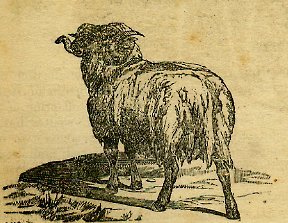
Recorded by
Figgy Duff
The Kossoy Sisters and Erin Darling
Muckram Wakes
Pete Seeger
